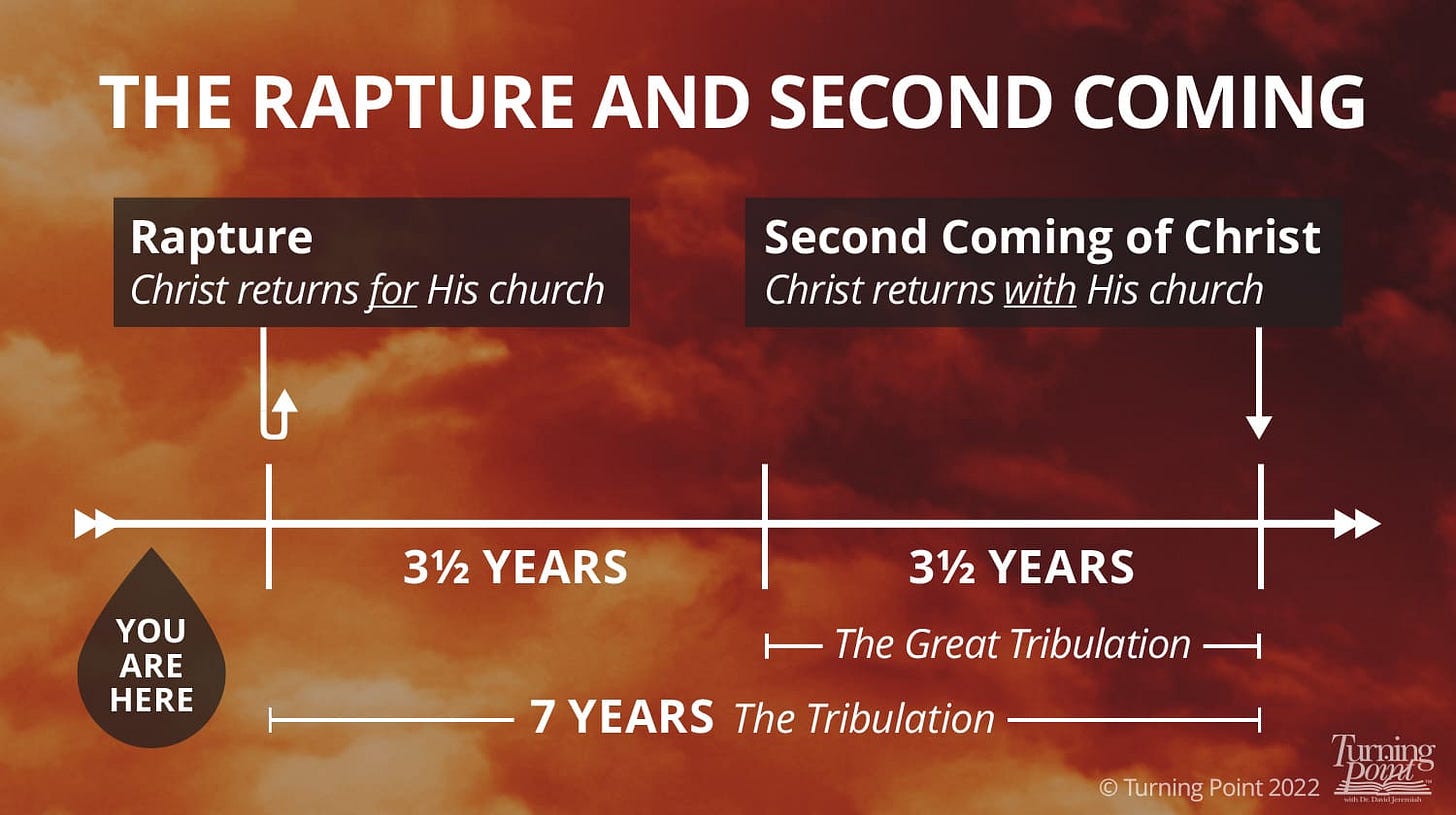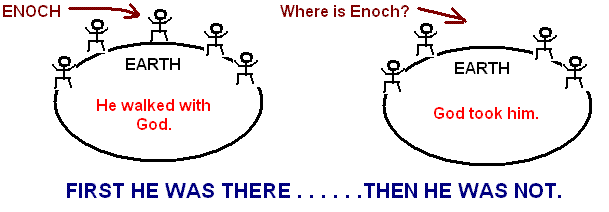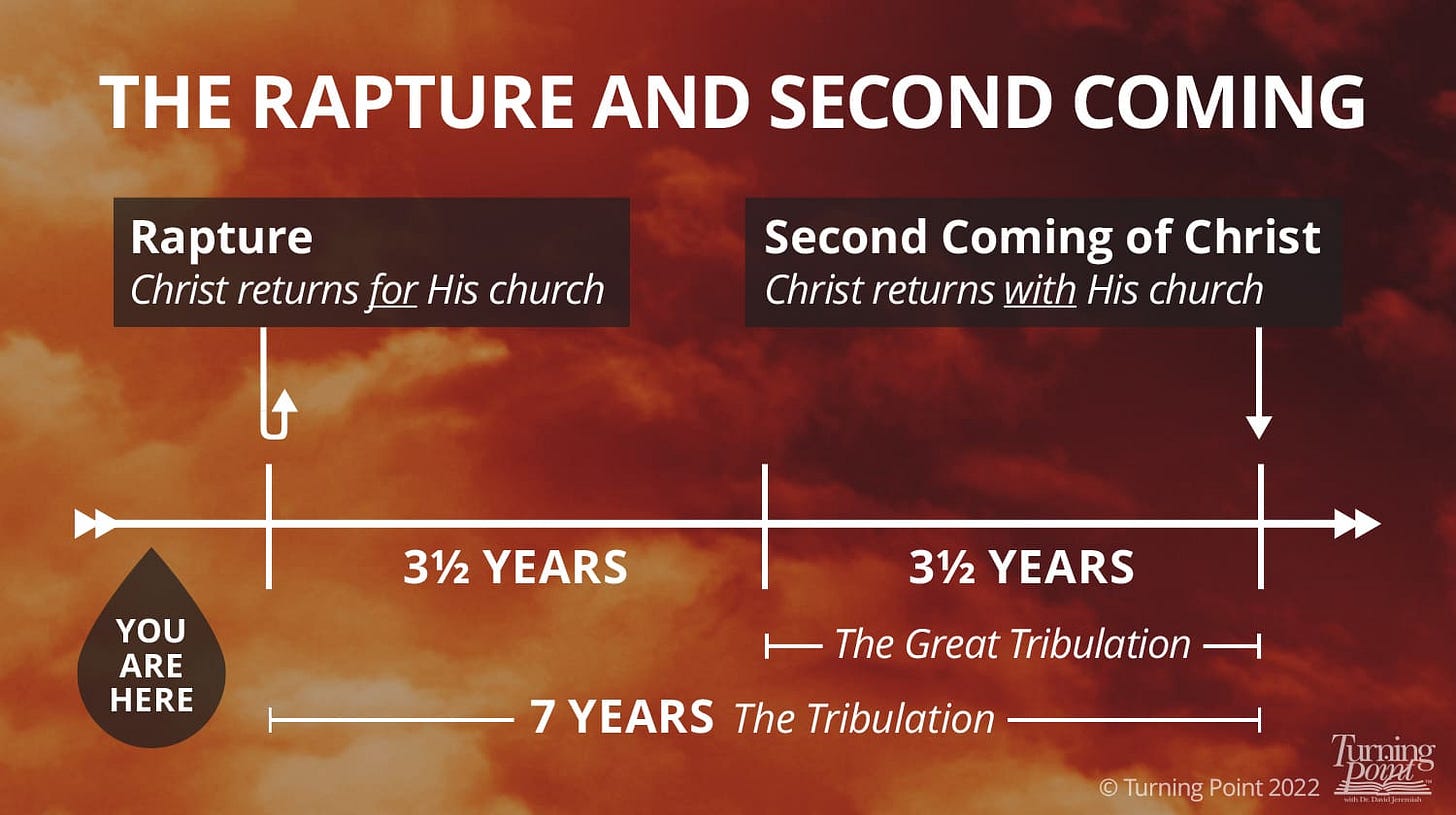The Pre-Tribulation Rapture: A Biblical and Theological Exploration
Unpacking the Case for Christ’s Imminent Return
The doctrine of the Pre-Tribulation Rapture—the belief that the Church will be taken to heaven before the seven-year Tribulation—has sparked fascination, debate, and hope for generations. Rooted in Scripture and supported by prophetic patterns, this view offers a compelling framework for understanding end-times events.
Below, we delve into the biblical, theological, and historical pillars that undergird this perspective.
1. The Rapture and Second Coming: Two Distinct Events
A foundational distinction separates the Rapture (Christ’s return for His Church) and the Second Coming (Christ’s return with His Church to establish His kingdom). Key differences include:
Location:
Rapture: Believers meet Christ in the air (1 Thessalonians 4:17).
Second Coming: Christ descends to the Mount of Olives (Zechariah 14:4).
Purpose:
Rapture: Deliverance of the Church from wrath (1 Thessalonians 1:10).
Second Coming: Deliverance of believers who endured wrath (Revelation 19:11-21).
Signs:
Rapture: No preceding signs; described as sudden and imminent (Matthew 24:36-44).
Second Coming: Follows a cascade of Tribulation events (Matthew 24:15-30).
This dichotomy rules out a Post-Tribulation Rapture, as the two events cannot coexist temporally or functionally.
2. Imminence: “At an Hour You Do Not Expect”
Scripture repeatedly emphasizes Christ’s return as unpredictable and without warning:
- “Therefore keep watch, because you do not know on what day your Lord will come” (Matthew 24:42).
- “The day of the Lord will come like a thief in the night” (1 Thessalonians 5:2).
By contrast, the Second Coming is preceded by:
- The rise of the Antichrist (2 Thessalonians 2:3-4).
- The rebuilding of the Jewish Temple (Revelation 11:1-2).
- Global judgments (Revelation 6-18).
If the Rapture occurred mid- or post-Tribulation, believers would anticipate Christ’s return based on these signs—contradicting the call to “watch expectantly” (Titus 2:13).
3. The Restrainer and the Antichrist’s Rise
Paul’s second letter to the Thessalonians clarifies a critical sequence:
- The Antichrist cannot be revealed until “the one who now restrains” is removed (2 Thessalonians 2:6-7).
- The Restrainer—identified as the Holy Spirit working through the Church—must be taken before the Tribulation begins.
This aligns with Daniel 9:27, where the Antichrist’s covenant with Israel initiates the seven-year countdown. The Church’s absence during this period is thus necessitated.
4. Israel’s Redemption: The Focus of Tribulation
Jeremiah 30:7 calls the Tribulation “the time of Jacob’s trouble”—a period of refining and salvation for Israel. Key indicators include:
- The woman in Revelation 12 (symbolizing Israel) fleeing persecution.
- Two-thirds of Jews perishing before a remnant cries out to Messiah (Zechariah 13:8-9).
- Satan’s fury against Israel for birthing the Messiah (Revelation 12:17).
The Church, grafted into God’s promises (Romans 11:17-24), has no role in this uniquely Jewish redemptive arc.
5. The Church’s Exemption from Divine Wrath
God’s wrath during the Tribulation targets unrepentant humanity, not the Church:
- “God did not appoint us to suffer wrath but to receive salvation” (1 Thessalonians 5:9).
- The Church of Philadelphia is promised deliverance “from the hour of trial” (Revelation 3:10).
While believers endure human persecution (John 16:33), the Tribulation’s global cataclysms (seals, trumpets, bowls) represent divine judgment—a fate the Church is spared.
6. The Full Seven Years: Unbroken Wrath
Some argue God’s wrath is limited to the Tribulation’s second half. Yet Scripture confirms:
- Jesus Himself opens the seal judgments (Revelation 6:1), initiating wrath from the outset.
- The bowl judgments conclude God’s wrath (Revelation 15:1), spanning the entire period.
Thus, the Church must be removed before the first seal is broken.
7. The Church’s Absence in Tribulation Prophecy
Old Testament prophets and Revelation 4–18 focus exclusively on Israel and unbelieving nations during the Tribulation. The Church—absent from these passages—reappears in Revelation 19:14, returning with Christ at the Second Coming.
This “parenthesis” aligns with the Church’s mysterious nature (Ephesians 3:3-6), unknown to Old Testament writers.
8. The Church’s Heavenly Activities
During the Tribulation, the raptured Church engages in three key events:
1. The Judgment Seat of Christ (2 Corinthians 5:10): Evaluation of believers’ works for rewards.
2. The Marriage Supper of the Lamb (Revelation 19:7-9): Celebration of Christ’s union with His Bride.
3. Preparation for Armageddon (Revelation 19:14): The Church returns with Christ to execute justice.
These activities necessitate a Pre-Tribulation departure.
9. The Sheep and Goats Judgment
Post-Tribulation Rapture theology struggles with Matthew 25:31-46, where Christ separates “sheep” (believers) from “goats” (unbelievers). If all believers were raptured and glorified at the Second Coming, no mortal “sheep” would remain to populate Christ’s millennial kingdom.
A Pre-Tribulation Rapture allows for a remnant of Tribulation saints to enter the Millennium in natural bodies (Isaiah 65:20-23).
10. Biblical Precedent: Rescuing the Righteous
God consistently delivers His people before pouring out wrath:
- Noah was sealed in the ark pre-Flood (Genesis 7:16).
- Lot was removed pre-Sodom’s destruction (Genesis 19:22).
- Rahab was spared pre-Jericho’s fall (Joshua 6:25).
The Church, as Christ’s Bride, follows this pattern of divine exemption.
11. Historical Validity: Not a Modern Invention
Critics claim the Pre-Tribulation view originated with John Darby in the 1800s. However, early church fathers like Irenaeus (120-202) and Hippolytus taught Christ’s imminent return. Medieval writers like Ephraem of Nisibis also distinguished the Rapture from the Second Coming.
During and after the Reformation, theologians such as Joseph Mede (1586-1638) and Increase Mather (1639-1723) further articulated these ideas. Thus, while Darby popularized Pre-Tribulation theology in modern times, its roots extend far deeper into Church history
Thus, the Pre-Tribulation view is neither novel nor unbiblical.
12. The Nature of the Church: A Unique Entity
The Church’s distinct identity as the Body of Christ (Ephesians 1:22-23) and Bride of Christ (Revelation 21:9) sets it apart from Israel and Tribulation saints. Key distinctions include:
- The Church’s Formation: Born at Pentecost (Acts 2), the Church is a New Covenant community of Jews and Gentiles united in Christ (Galatians 3:28).
- Israel’s Covenants: God’s promises to Israel (e.g., land, kingdom, priesthood) remain unfulfilled and await completion during the Tribulation and Millennium (Jeremiah 31:31-34; Ezekiel 36:24-28).
- Tribulation Saints: Those saved after the Rapture endure unparalleled persecution (Revelation 7:14) but are distinct from the Church, which is “seated in heavenly places” (Ephesians 2:6).
This theological separation underscores why the Church cannot be present during Israel’s appointed refining.
13. The Typology of Enoch: A Pre-Wrath Parallel
Enoch, who was “taken so that he did not see death” (Hebrews 11:5), serves as a striking type of the Pre-Tribulation Rapture:
- Timing: Enoch was removed before the Flood’s judgment, just as the Church will be removed before God’s wrath.
- Character: Enoch “walked faithfully with God” (Genesis 5:24), mirroring the Church’s call to holiness (1 Thessalonians 4:7).
- Purpose: His removal signaled God’s grace to the righteous, a pattern repeated in the Rapture.
This Old Testament foreshadowing reinforces the consistency of God’s deliverance strategy.
14. The Danger of Date-Setting: Guarding Against Distraction
While the Rapture’s imminence fuels urgency, Scripture warns against date-setting:
- “It is not for you to know times or seasons that the Father has fixed by His own authority” (Acts 1:7).
- False prophets will exploit end-times anxiety (Matthew 24:23-26), but the Church’s focus must remain on spiritual readiness (Luke 12:35-40).
The Pre-Tribulation view safeguards against disillusionment, as believers are called to live in constant anticipation, not cyclical speculation.
15. The Global Harvest: Evangelism After the Rapture
Post-Rapture, God initiates an unprecedented evangelistic campaign:
- 144,000 Jewish Evangelists: Sealed and protected, they preach the Gospel (Revelation 7:1-8; 14:1-5).
- The Two Witnesses: Miracle-working prophets in Jerusalem (Revelation 11:3-12).
- An Angelic Proclamation: An angel declares the “eternal gospel” to all nations (Revelation 14:6-7).
This divine campaign results in a multitude of Tribulation saints (Revelation 7:9), proving God’s mercy even amid judgment.
16. The Rapture’s Practical Impact: Living With Eternal Perspective
Belief in the Pre-Tribulation Rapture is not mere academic theory—it transforms daily living:
- Moral Purity: “Everyone who has this hope fixed on Him purifies himself” (1 John 3:3).
- Urgent Mission: “Rescue those being led away to death” (Proverbs 24:11).
- Comfort in Grief: Assurance that departed believers will rise first (1 Thessalonians 4:13-18).
This doctrine fuels perseverance, as Paul urges: “Stand firm. Let nothing move you. Always give yourselves fully to the work of the Lord” (1 Corinthians 15:58).
17. Addressing Common Objections
Critics raise questions worth engaging:
Q: “Doesn’t the Church need purification through Tribulation suffering?”
A: The Church is already “washed…sanctified…justified” (1 Corinthians 6:11). Trials refine faith (James 1:2-4), but the Tribulation’s wrath is punitive, not purifying.
Q: “Didn’t Jesus pray for unity, not escape?” (John 17:21).
A: Christ’s prayer for unity pertains to spiritual harmony, not shared suffering under wrath. The Rapture fulfills His promise to “come again and take you to Myself” (John 14:3).
Q: “Aren’t all believers called to endure to the end?” (Matthew 24:13).
A: This charge applies to Tribulation saints, not the Church. Contextually, Jesus addresses Jews in Judea (Matthew 24:16), not the Body of Christ.
18. The Bigger Picture: God’s Unfolding Master Plan
The Pre-Tribulation Rapture fits seamlessly into Scripture’s grand narrative:
1. Creation: Humanity’s fall (Genesis 3).
2. Redemption: Christ’s cross and resurrection (John 3:16).
3. Church Age: Grace to all nations (Acts 15:14).
4. Tribulation: Israel’s restoration and judgment on rebellion.
5. Millennium: Christ’s righteous reign (Revelation 20:4).
6. Eternity: New heavens and earth (Revelation 21:1).
Each phase reveals God’s sovereignty, justice, and relentless love.
Final Encouragement: “Look Up!”
Jesus’ command to “lift up your heads, because your redemption is drawing near” (Luke 21:28) transcends eschatological debates. Whether through Rapture or resurrection, every believer’s destiny is secure: “To live is Christ, and to die is gain” (Philippians 1:21).
As darkness deepens, let us anchor in this truth: Our King is coming. Maranatha!
Conclusion: A Blessed Hope for the Church
The Pre-Tribulation Rapture offers believers a “blessed hope” (Titus 2:13)—a promise of deliverance and eternal union with Christ. While eschatological debates persist, this view aligns with Scripture’s urgent call to “comfort one another with these words” (1 Thessalonians 4:18).
As we await His coming, let us live with readiness, purpose, and anticipation, knowing that “our citizenship is in heaven” (Philippians 3:20).
Thank you for reading this in-depth exploration. If you value content that equips believers with biblical truth, consider supporting News and Knees Substack. Your subscription fuels our mission to provide thoughtful, Christ-centered analysis in an age of confusion. Together, let’s “encourage one another—and all the more as you see the Day approaching” (Hebrews 10:25).
N.B: I thank God for giving me the grace to come across this post. I am not the original author. I read it through .. loved it and just organized it in this manner. To check the original source pls check here.










Also, this one is very good too! https://olivetreeviews.org/radio-archives/is-there-a-scofield-rothschild-conspiracy-who-knew/
I will put my trust in the 2000-year-old Catholic Church's theology. https://dmsbcatholic.com/wp-content/uploads/2020/11/The-Rapture.pdf- Compiled by Fr. Martin Pitstick. Updated 11/11/20o and https://www.catholiccompany.com/content/what-the-catholic-church-teaches-about-the-rapture.